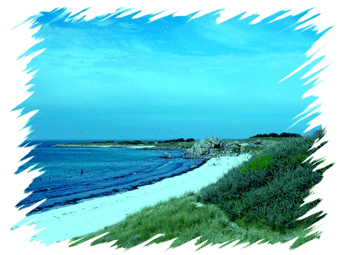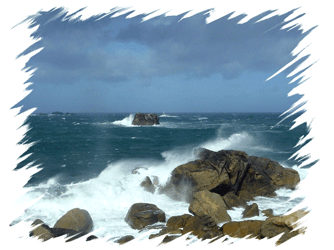Ploudalmézeau in Brittany
625

Ploudalmézeau is a
rather weird name for a very ordinary Breton town. “Ploudalmézeau”
derives from the Breton Gwitalmézé, roughly “the parish before the
plain:” plou: parish; dal, in front of;, mezon, plain or countryside.
That “Plou” means parish is the explanation for the seemingly hundreds
of “Plou . . .” place names in Brittany, though not as common as the
“Ker . . .” names for houses –ker is the Breton word for house or home,
so Kerjean translates to John’s place.
Ploudalmézeau’s
place in front of the plain, or the countryside, makes sense when you
approach from the sea: standing atop a rise in the ground, the church
spire is a distinctive landmark. It also has the distinction of being
the last gothic-style steeple built in France, in 1776. When we return
from our frequent trips away, that spire tells us that we are truly
home. Today, though, the skyline is dominated by the Château d’eau, the
water tower, a kilometre or so outside the town, but the stark form of
the water tower does not have the same romance as our steeple. Indeed,
the best view to be had of the area is the only one that excludes the
water tower – from the windows of the crêperie at the top of the tower.
From here you can see the plains inland – rich farming country; the
English Channel to the North and the Atlantic to the West – the
coastlines that define this country. The
coastline is as rich and varied as you could wish. To the north-east
you can just see the tall lighthouse of L’Ile Vièrge, then the inlet of
the Aber Benoît, a sailor’s haven. Along the northern coastline are
miles of clean yellow sand, the beaches of Trois Moutons (three sheep –
we think from the little rocky islands just offshore). Trois Moutons is
the home of the kite surfers – most days of the year you can see the
coloured arcs of their kites moving above the dunes. Then comes the
rocky outcrop of the Serpent and our favourite beach at Treompan – a
sheltered sandy cove a kilometre or more long with maybe a few walkers,
a fisherman out for sea bass and a couple of horses and riders to
disturb the stillness. Not far
beyond Treompan you turn the corner towards the Atlantic Coast and
reach the Portsall, a working fishing port. The coastline turns rocky
and you are on the Côte Sauvage – the savage coast — where the big
Atlantic rollers crash on the rocky cliffs. The views are spectacular;
the sea air takes away the cobwebs in seconds. With the occasional
sandy beach or fishing harbour the Côte Sauvage runs south to Lanildut,
the mouth of the Aber Ildut and the end of our little corner of
Brittany, over the hill and out of sight of our view from the water
tower. The
three Abers Benoît, Ildut and, further east, the Aber Wrac’h are
unique, at least in France: they are glacial inlets — related
perhaps to the fjords of Norway in origin if not in scale. They are
each sheltered tidal inlets, the home to fishermen, oysters, yachts and
wildlife. I love to drive our visitors back from the airport in Brest
along the Route Touristique and stop at a viewpoint high over the Aber
Benoît where you can look down at the still water surrounded by dense
green woods inviting long summer walks along the waterside paths. Sandy
beaches, rocky cliffs, wooded inlets, rolling fields, fishing ports and
all within a few kilometres of our door here. Who’d want that? Bob
Janes and his wife Jane Revell divide their time between rural Brittany
and urban London – a tough choice. Bob is an occasional organisational
consultant and coach and an avowed internet tekkie. He enjoys having
choices about his life after 25 years in international business,
working in finance, strategy and change management. Jane is a writer,
teacher and trainer in personal development and English as a Foreign
Language.
More at www.bobjanes.com and www.janerevell.com
- SUBSCRIBE
- ALREADY SUBSCRIBED?
BECOME A BONJOUR PARIS MEMBER
Gain full access to our collection of over 5,000 articles and bring the City of Light into your life. Just 60 USD per year.
Find out why you should become a member here.
Sign in
Fill in your credentials below.
Ploudalmézeau is a
rather weird name for a very ordinary Breton town. “Ploudalmézeau”
derives from the Breton Gwitalmézé, roughly “the parish before the
plain:” plou: parish; dal, in front of;, mezon, plain or countryside.
That “Plou” means parish is the explanation for the seemingly hundreds
of “Plou . . .” place names in Brittany, though not as common as the
“Ker . . .” names for houses –ker is the Breton word for house or home,
so Kerjean translates to John’s place.
rather weird name for a very ordinary Breton town. “Ploudalmézeau”
derives from the Breton Gwitalmézé, roughly “the parish before the
plain:” plou: parish; dal, in front of;, mezon, plain or countryside.
That “Plou” means parish is the explanation for the seemingly hundreds
of “Plou . . .” place names in Brittany, though not as common as the
“Ker . . .” names for houses –ker is the Breton word for house or home,
so Kerjean translates to John’s place.
Ploudalmézeau’s
place in front of the plain, or the countryside, makes sense when you
approach from the sea: standing atop a rise in the ground, the church
spire is a distinctive landmark. It also has the distinction of being
the last gothic-style steeple built in France, in 1776. When we return
from our frequent trips away, that spire tells us that we are truly
home. Today, though, the skyline is dominated by the Château d’eau, the
water tower, a kilometre or so outside the town, but the stark form of
the water tower does not have the same romance as our steeple. Indeed,
the best view to be had of the area is the only one that excludes the
water tower – from the windows of the crêperie at the top of the tower.
From here you can see the plains inland – rich farming country; the
English Channel to the North and the Atlantic to the West – the
coastlines that define this country.
place in front of the plain, or the countryside, makes sense when you
approach from the sea: standing atop a rise in the ground, the church
spire is a distinctive landmark. It also has the distinction of being
the last gothic-style steeple built in France, in 1776. When we return
from our frequent trips away, that spire tells us that we are truly
home. Today, though, the skyline is dominated by the Château d’eau, the
water tower, a kilometre or so outside the town, but the stark form of
the water tower does not have the same romance as our steeple. Indeed,
the best view to be had of the area is the only one that excludes the
water tower – from the windows of the crêperie at the top of the tower.
From here you can see the plains inland – rich farming country; the
English Channel to the North and the Atlantic to the West – the
coastlines that define this country.
 The
Thecoastline is as rich and varied as you could wish. To the north-east
you can just see the tall lighthouse of L’Ile Vièrge, then the inlet of
the Aber Benoît, a sailor’s haven. Along the northern coastline are
miles of clean yellow sand, the beaches of Trois Moutons (three sheep –
we think from the little rocky islands just offshore). Trois Moutons is
the home of the kite surfers – most days of the year you can see the
coloured arcs of their kites moving above the dunes. Then comes the
rocky outcrop of the Serpent and our favourite beach at Treompan – a
sheltered sandy cove a kilometre or more long with maybe a few walkers,
a fisherman out for sea bass and a couple of horses and riders to
disturb the stillness.
Not far
beyond Treompan you turn the corner towards the Atlantic Coast and
reach the Portsall, a working fishing port. The coastline turns rocky
and you are on the Côte Sauvage – the savage coast — where the big
Atlantic rollers crash on the rocky cliffs. The views are spectacular;
the sea air takes away the cobwebs in seconds. With the occasional
sandy beach or fishing harbour the Côte Sauvage runs south to Lanildut,
the mouth of the Aber Ildut and the end of our little corner of
Brittany, over the hill and out of sight of our view from the water
tower.
beyond Treompan you turn the corner towards the Atlantic Coast and
reach the Portsall, a working fishing port. The coastline turns rocky
and you are on the Côte Sauvage – the savage coast — where the big
Atlantic rollers crash on the rocky cliffs. The views are spectacular;
the sea air takes away the cobwebs in seconds. With the occasional
sandy beach or fishing harbour the Côte Sauvage runs south to Lanildut,
the mouth of the Aber Ildut and the end of our little corner of
Brittany, over the hill and out of sight of our view from the water
tower.
 The
Thethree Abers Benoît, Ildut and, further east, the Aber Wrac’h are
unique, at least in France: they are glacial inlets — related
perhaps to the fjords of Norway in origin if not in scale. They are
each sheltered tidal inlets, the home to fishermen, oysters, yachts and
wildlife. I love to drive our visitors back from the airport in Brest
along the Route Touristique and stop at a viewpoint high over the Aber
Benoît where you can look down at the still water surrounded by dense
green woods inviting long summer walks along the waterside paths.
Sandy
beaches, rocky cliffs, wooded inlets, rolling fields, fishing ports and
all within a few kilometres of our door here. Who’d want that?
beaches, rocky cliffs, wooded inlets, rolling fields, fishing ports and
all within a few kilometres of our door here. Who’d want that?
Bob
Janes and his wife Jane Revell divide their time between rural Brittany
and urban London – a tough choice. Bob is an occasional organisational
consultant and coach and an avowed internet tekkie. He enjoys having
choices about his life after 25 years in international business,
working in finance, strategy and change management. Jane is a writer,
teacher and trainer in personal development and English as a Foreign
Language.


